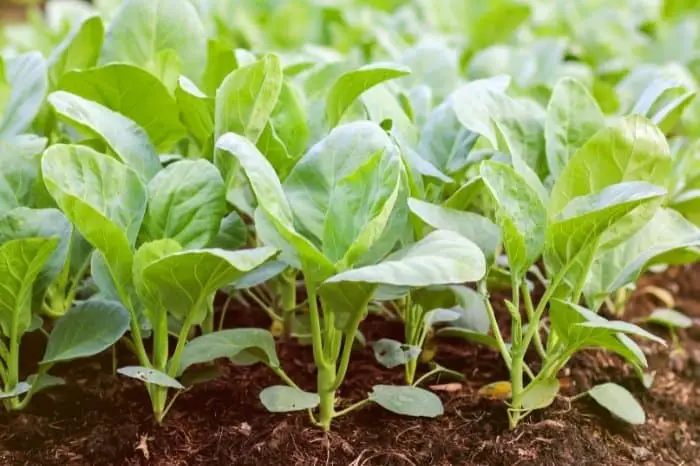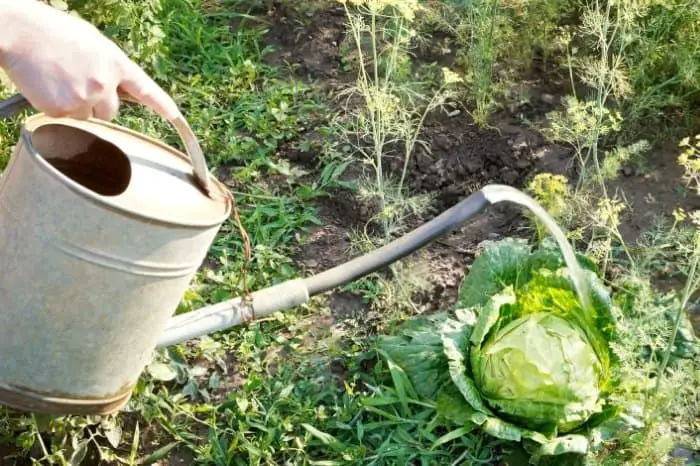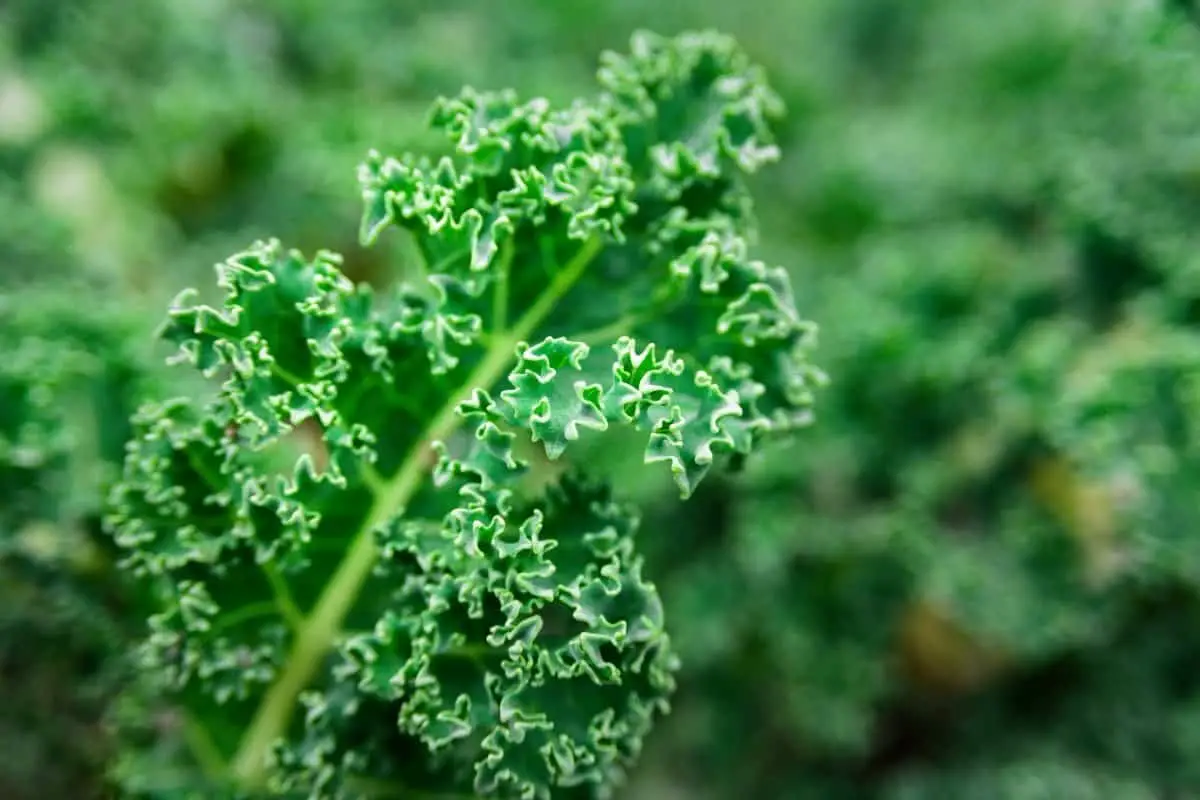Last Updated on February 10, 2022 by
How long does it take to grow kale is a question we will answer to enlighten many gardeners on this topic.
Kale is a cool-weather crop packed with iron, fiber, vitamins K, A, and C, and calcium. It is an amazing plant to grow and a great way to get more of it if you grow your own.
This plant is grown as an annual, but it’s a hardy biennial plant. Its leaves are similar to cabbage.
Scotch kale comes with crumpled and curly grey-green leaves, while Siberian or blue kale is less curly and has a bluer shade of green.
Growing kale is not only for seasoned gardeners; you can grow them too. A few plants can supply your family with enough kales for a family meal. You don’t even need a garden to grow kales; they also do well in containers. Just make sure your container is at least 12-inch in diameter and use the good potting mix to allow proper drainage.
How Long Does Kale Take To Grow?
If you plant your kale from seeds, you can expect to harvest in 70 days. These plants require about 2 months of cool weather from planting to harvesting.
Transplanted kale seedlings already have a head start on seeds, so you can expect these to be ready for harvest in about 55 days after planting.

Picking Baby Kale
However, the timeline for picking baby kale is shorter than for harvesting full-sized kale. You can start to harvest baby kale leaves in about 25 days after planting the seeds. Baby kale is ready for picking and eating when the plants are about 4 inches tall.
Baby kales are easy to pick. Hold the small plants into handfuls and cut the stems with a sharp knife or scissors. Leave about 2 inches of stem on each plant to allow the leaves to regrow.
Types Of Kale You Can Grow
Kale has many varieties that are worth growing. The curly-leaf varieties are most common and tend to hang on longer in cold weather. The flat-leaf type becomes established faster than the curly. Here are some varieties to consider.
- Lacinato. This is a puckered heirloom kale from Tuscany. It is also known as Tuscan or dinosaur kale. It has thick leaves that are hardy enough to be harvested even after a snowfall.
- Hanover Salad. This variety is a fast grower and an early producer. It has a unique good taste for eating raw in salads.
- Redbor. This type has magenta leaves with curly edges. It carries a mild, crisp flavor and texture.
- Red Russian. The variety has tender leaves that are smooth with purple veins and edges. It is one of the sweetest varieties of kale.
- Vates. This is a curly, dwarf, bluish-green kale that tolerates both the heat and cold. It originates from the Dwarf Blue Curled Scotch kale. This type matures in about 55 days.
Survival Garden 15,000 Non GMO Heirloom Vegetable Seeds – 32 Variety Pack by Open Seed Vault
Planting Kale – A Guide To Grow Kale
When To Plant
According to your area’s forecast, Kale is best planted 3 to 5 weeks before the last frost date in the spring. You can also plant kales in the late summer, about 6 to 8 weeks before your first fall frost.
If you live in warm climate areas zone 8 and above, you can continue to plant in the early fall for a late fall to winter harvest.
Where To Grow Kale
Kale grows equally well in containers, garden soil, or raised gardens. You can grow kale indoors as long as you have adequate lighting. Rich soil with organic matter and good drainage are ideal. It should have a pH value of 5.5 to 6.8. The ideal site should also get lots of sunlight, but you can grow them in partial shade in warmer areas. Ensure that your kales are not too close to taller plants that will shade them.
Starting Kale Seeds
Though kales love some good sun, they can become woody and bitter if they receive too much sun. They best mature in cool temperatures retaining their good taste. You can start the seeds indoors in spring at least 6 weeks before the last frost to give the plants time to mature before summer’s worst heat.
Kale started from seeds matures in 55 to 75 days, while transplants will speed up the process and be ready for harvest in about 30 to 40 days.
If you want to have a winter harvest, plant your crop in the fall, at least 6 to 8 weeks before the first expected frost. You will harvest this crop even after winter sets in.
Kale’s Spacing And Depth
Kales should be spaced out properly to give them a good crop. Space kale plants at least 1.5 to 2 feet apart, and plant them in the same depth they grew in their nursery.
Kale seeds should be planted at least ½ inch deep.
Caring For Kale Plants
Soil
Kale plants prefer soil that is rich in organic matter with a slightly acidic ph. Organic matter provides the high nitrogen content necessary for healthy leaf growth. The soil must also drain well to avoid water retention.
Light
Kale thrives well in full to part shade. The best growth happens when the plant gets at least 6 or more hours of direct sunlight on most days.
However, if you live in a hot, dry climate, give your plant some shade, especially during the strong afternoon sun. Too much heat makes the leaves wilt and loses their zest.
Watering
Water your kales frequently so the soil stays evenly moist and not soggy. Kale likes at least 1 to 1.5 inches of water every week.
Cool temperatures and moist soil help give the kale leaves a sweet and crisp taste, rather than tough and bitter. You can mulch around your plants to keep the soil cool and help it retain moisture.

Harvesting Your Kale
The best time to harvest your kales is when they are about the size of your hand. Pick your kales one by one starting with the lowest outermost leaves and working towards the center.
Do not harvest all the leaves; leave a few smaller and closer to the center. You will be able to harvest from the same plant again in 5 to 7 days.
FAQs
Is kale hard to grow?
Not really. If you’re willing to put in the time and effort, it’s worth it! Kale is a cool-season plant that is grown for its tender leaves, which are great in salads. It grows well in partial shade and tolerates heat, drought, and even some salt.
Kale is easy to grow and can be sown directly into containers in early spring.
It's best grown in full sun or part shade, but can tolerate a little shade as well. If you want to grow it in your vegetable garden, sow seeds in early spring and thin the seedlings out when they're about 3 inches tall.
Does kale need full sun?
Kale is one of the most popular leafy green vegetables available today. You should plant your kale in full sun and not partial shade. It can be challenging to grow in colder climates. If you live in a cold climate, you might not have access to fresh kale until late spring or early summer. The best kale for eating comes from warmer climates.
In short, kale is a favorite among gardeners because it can tolerate a wide range of conditions. It's easy to grow, and has low maintenance requirements. Kale is a cool-season crop that grows well in the spring and fall.
Can kale grow in hot weather?
Kale is a cool-season plant, so it will bolt when the weather gets too warm. This happens when temperatures get above 70 degrees. Kale's taste becomes bitter and leaves become spindly.Then you can't grow kale in the summer. Kale is also one of the first plants to start growing in spring and continues to grow until frost.
When plants are mature, harvest them by snipping them from the ground with a knife or pulling them up. Leaves may need to be removed.
Does kale grow slowly?
The Healthy Green Powerhouse Kale is a leafy green vegetable from the cabbage family. It has long been used as a food and medicine in many cultures, but now it's making its way into modern cuisine. It's rich in vitamins C and K, antioxidants, minerals, and protein, and is one of the best sources of beta-carotene.
Kale, collard greens, and other members of the cabbage family are all known to grow slowly. They produce large heads, which are generally harvested when they are small and tender. The leaves are picked from the head when it is still young, before the head reaches maturity.
What month do you harvest kale?
“October” is probably the best time. It’s a nice transition from hot weather to cooler weather.
How do you grow kale outdoors?
To grow kale in the garden, it is best to start seeds indoors and transplant the seedlings to the garden. In general, you can sow kale seeds as soon as the soil is warm enough, but keep in mind that the leaves are more tender when they are young. Keep Learning Kale is a member of the cabbage family, which means that it should be started indoors before planting outside.
When you grow plants from seeds, you need to provide the right environment for them to thrive and grow. This is where hydroponics comes in handy. It is a method of growing plants that uses nutrient-rich water instead of soil.
Does kale grow in winter?
Kale doesn’t have an issue growing in winter, but it does need more care and attention. You should only remove weeds and dead leaves when the plant is dormant. Don’t feed your kale! This may seem counterintuitive at first, but kale doesn’t like to be overfed, so resist the urge to fertilize it.
Finally
FAQs
Is kale hard to grow?
Not really. If you’re willing to put in the time and effort, it’s worth it! Kale is a cool-season plant that is grown for its tender leaves, which are great in salads. It grows well in partial shade and tolerates heat, drought, and even some salt.
Kale is easy to grow and can be sown directly into containers in early spring.
It's best grown in full sun or part shade, but can tolerate a little shade as well. If you want to grow it in your vegetable garden, sow seeds in early spring and thin the seedlings out when they're about 3 inches tall.
Does kale need full sun?
Kale is one of the most popular leafy green vegetables available today. You should plant your kale in full sun and not partial shade. It can be challenging to grow in colder climates. If you live in a cold climate, you might not have access to fresh kale until late spring or early summer. The best kale for eating comes from warmer climates.
In short, kale is a favorite among gardeners because it can tolerate a wide range of conditions. It's easy to grow, and has low maintenance requirements. Kale is a cool-season crop that grows well in the spring and fall.
Can kale grow in hot weather?
Kale is a cool-season plant, so it will bolt when the weather gets too warm. This happens when temperatures get above 70 degrees. Kale's taste becomes bitter and leaves become spindly.Then you can't grow kale in the summer. Kale is also one of the first plants to start growing in spring and continues to grow until frost.
When plants are mature, harvest them by snipping them from the ground with a knife or pulling them up. Leaves may need to be removed.
Does kale grow slowly?
The Healthy Green Powerhouse Kale is a leafy green vegetable from the cabbage family. It has long been used as a food and medicine in many cultures, but now it's making its way into modern cuisine. It's rich in vitamins C and K, antioxidants, minerals, and protein, and is one of the best sources of beta-carotene.
Kale, collard greens, and other members of the cabbage family are all known to grow slowly. They produce large heads, which are generally harvested when they are small and tender. The leaves are picked from the head when it is still young, before the head reaches maturity.
What month do you harvest kale?
“October” is probably the best time. It’s a nice transition from hot weather to cooler weather.
How do you grow kale outdoors?
To grow kale in the garden, it is best to start seeds indoors and transplant the seedlings to the garden. In general, you can sow kale seeds as soon as the soil is warm enough, but keep in mind that the leaves are more tender when they are young. Keep Learning Kale is a member of the cabbage family, which means that it should be started indoors before planting outside.
When you grow plants from seeds, you need to provide the right environment for them to thrive and grow. This is where hydroponics comes in handy. It is a method of growing plants that uses nutrient-rich water instead of soil.
Does kale grow in winter?
Kale doesn’t have an issue growing in winter, but it does need more care and attention. You should only remove weeds and dead leaves when the plant is dormant. Don’t feed your kale! This may seem counterintuitive at first, but kale doesn’t like to be overfed, so resist the urge to fertilize it.
Kale is a healthy green rich in minerals and vitamins, and you can eat it steamed, boiled, blanched or braised.
Remember, kale takes a little longer than its Brassica cousins do to soften, so give it some little more time.
Keep your harvested greens washed and dried for a couple of days or in a salad crisper.
Have a happy kale gardening, won’t you?
Caroline is a gardener who loves to get down to the nitty–gritty of gardening. She proudly proclaims herself as a ‘dirt worshipper‘ and can often be found deep in the garden, covered in soil and singing to her plants. As a self–proclaimed ‘plant whisperer‘, Caroline believes that plants need love and attention just like any other living thing, and she loves to give them both. When she‘s not tending to her garden, you can often find her researching the latest gardening trends, or teaching others how to make their gardens thrive



